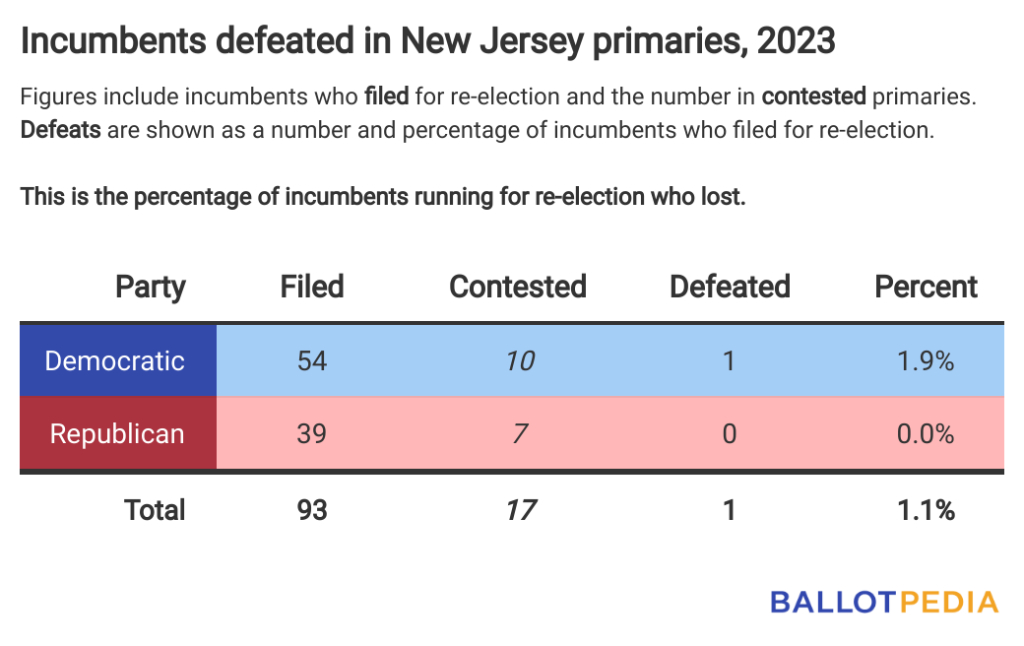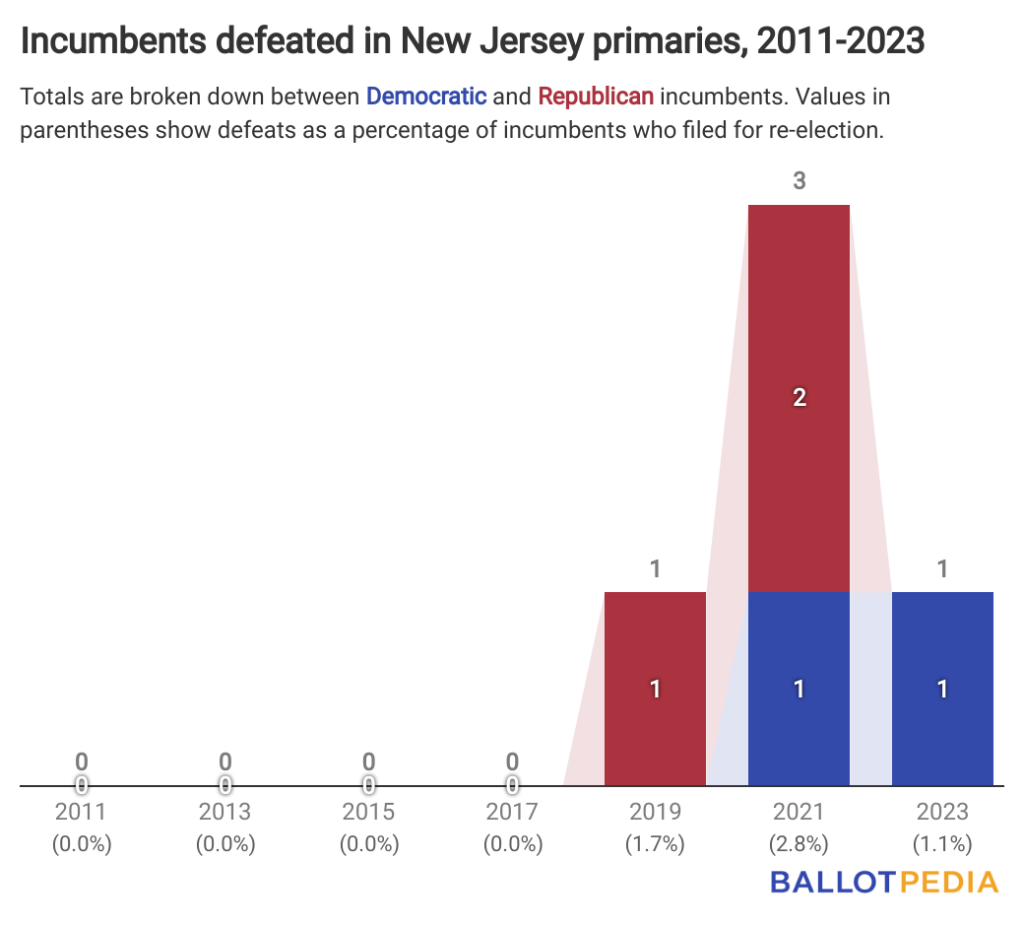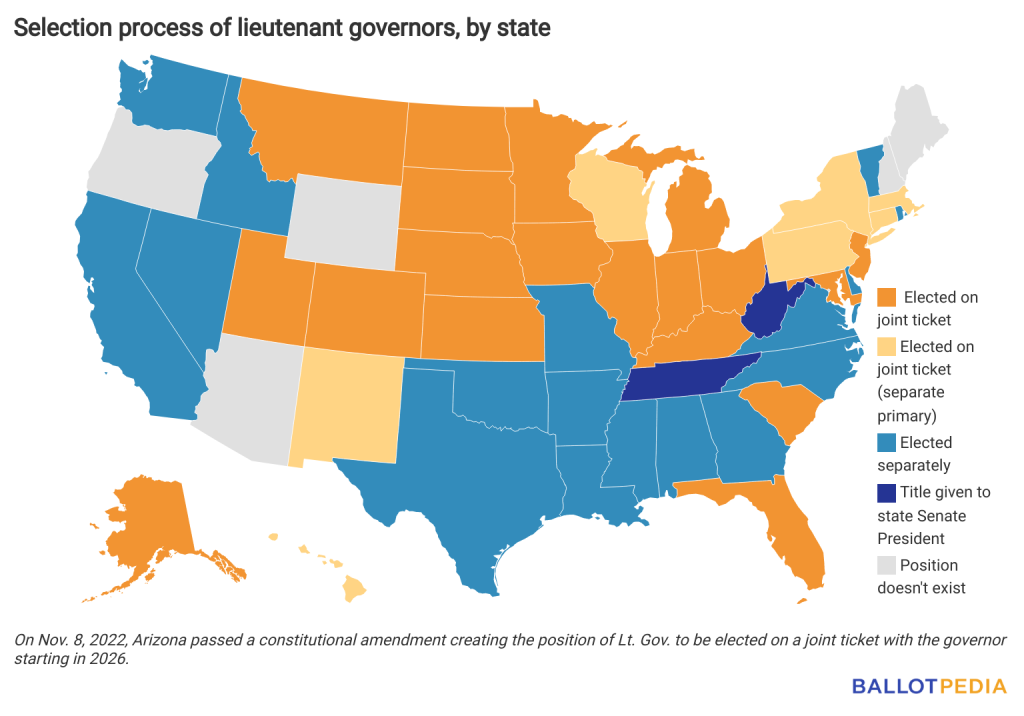Welcome to the Thursday, June 8, Brew.
Here’s what’s in store for you as you start your day:
- Tuesday’s election results roundup: One incumbent loses in New Jersey, and Denver gets a new mayor
- On this date in 1976: Ohio voters approved the Ohio Joint Election of Governor and Lieutenant Governor Amendment
- A roundtable of Ballotpedia reporters discuss highlights from this year’s state legislative sessions in the latest episode of On the Ballot
Tuesday’s election results roundup: One incumbent loses in New Jersey, and Denver gets a new mayor
New Jersey held municipal and statewide legislative primaries on Tuesday, while Denver, Colorado, held a runoff election for mayor. Let’s dive into the key results:
One incumbent defeated in New Jersey's state legislative primaries
Seventeen incumbents faced contested primaries on Tuesday, and all but one advanced to the general election.
Democratic Sen. Nia Gill lost her primary, representing 1.1% of the 93 incumbents running for re-election. Overall, 76 incumbents, or 82% of the total running for re-election, didn’t face primary challengers and were guaranteed to advance to the general election.

It is uncommon for New Jersey legislative incumbents to lose in primaries.
From 2011 to 2017, no incumbents lost in primaries. In 2019, one Republican incumbent lost. A decade-high three incumbents lost primaries in 2021.

Gill's defeat comes in the state's only incumbent v. incumbent primary, where she faced fellow incumbent Richard Codey (D). The two ended up in the same district following redistricting, guaranteeing at least one would lose.
Both incumbents were long-standing members of the Senate. Gill assumed office in 2002 and Codey in 1982. Codey is running unopposed in the November general election.
Click here to learn more about state legislative incumbents defeated so far in 2023.
New Jersey is one of four states holding state legislative primaries in 2023, and the first to do so this year.
The next state legislative primary date is June 20 in Virginia, where 17 incumbents are running in contested primaries, including two incumbent v. incumbent primaries.
Mississippi will hold its state legislative primaries on Aug. 8, followed by Louisiana on Oct. 14.
HDCO-endorsed incumbents advance in Hudson County
In Hudson county, a slate of candidates who received endorsements from the Hudson County Democratic Organization (HCDO) defeated a slate who received endorsements from the Progressive Democrats of Hudson County (PDHC) in the six contested Democratic primaries for the board of commissioners.
Five of the Democratic primaries had an incumbent, and one was for an open position. The HCDO endorsed all five contested incumbents as well as Robert Baselice in the open race. None of the six PDHC endorsees were incumbents, including Stephanie Martinez running in the open race.
The HDCO is the county-level affiliate of the state Democratic Party, and the PDHC is the county-level affiliate of the Progressive Democrats of New Jersey.
No district had contested Republican primaries.
Additionally, HDCO-endorsed candidate Craig Guy defeated PDHC-endorsed Eleana Little in the Democratic primary for county executive. Guy is running unopposed in the November general election. Incumbent Thomas Degise (D), in office since 2002, did not seek re-election.
Elsewhere in New Jersey, Essex County held primaries for county surrogate and its board of commissioners. Click here to view those results.
Johnston defeats Brough in Denver’s mayoral runoff
In Colorado, former State Sen. Mike Johnston (D) defeated former Denver Metro Chamber of Commerce Kelly Brough in the runoff election for Denver mayor. As of this writing, Johnston had 56% to Brough’s 45%.
Johnston and Brough advanced from a field of 22 candidates in the April 4 general election. Incumbent Michael Hancock (D), first elected in 2011, was term-limited. This was Denver's fifth open mayoral election since 1959.
Ahead of the general election, Denverite's Kyle Harris wrote that Brough and Johnston were "centrist candidates ... [who] cleaved toward the middle, offering an optimistic vision while gently pushing for using policing in their homelessness solutions."
Both candidates highlighted public safety, homelessness, and housing affordability as key issues in this race.
Johnston’s endorsers included U.S. Rep. Brittany Pettersen (D), former Mayor Federico Peña, and a number of local unions. Brough’s endorsers included Gov. Bill Ritter (D), the Denver Police Protective Association, and the Denver Republican Party.
While the election was officially nonpartisan, Brough and Johnston are both Democrats.
We previewed this race in our May 30 edition. Click here to read more.
On this date in 1976: Ohio voters approved the Ohio Joint Election of Governor and Lieutenant Governor Amendment
Earlier this week, we told you about a historical ballot measure of note—Prop 13 on June 6. Today let’s explore another measure in our database, this time from Ohio.
Forty-seven years ago today, Ohio voters approved the Ohio Joint Election of Governor and Lieutenant Governor Amendment, a constitutional amendment providing that the lieutenant governor and governor run as a joint ticket in general elections.
The amendment also removed the lieutenant governor's duty to preside over the state Senate and gave the General Assembly the power to determine the method for nominating the lieutenant governor and governor.
Before the amendment’s implementation, Ohio’s governors and lieutenant governors were elected separately, which could result in officeholders from different parties. This happened 10 times in the 20th century, including in 1970, when Democrat John J. Gilligan was elected governor, and Republican John W. Brown was elected lieutenant governor.
In 1971, the Constitutional Revision Commission, a body created to suggest revisions to the state constitution, recommended “the Governor and the Lieutenant Governor be elected as a team, and that the General Assembly provide by law for the joint nomination of candidates for Governor and Lieutenant Governor.” The commission stated the change would “strengthen the executive role of the Lieutenant Governor and, by requiring political harmony between the two offices, insure continuity of public policy in the event of an abrupt transition of government.”
Gilligan and Brown both testified in favor of the change. Addressing the commission, Gilligan said:
“[...] It is the constitutional responsibility of the Lt. Governor to assume the duties of the Governor if the latter dies or becomes disabled. A close working relationship between the Governor and Lt. Governor will substantially ease the problems of the gubernatorial transition. I am certain that a Lt. Governor of the Governor's own party will play a major role in much of the discussion and decision making process in the Governor's office and will, therefore, be better equipped in an emergency to take over the duties of the State's Chief Executive."
Following the commission’s recommendation, the Ohio General Assembly referred the amendment to the ballot. Voters approved the measure 61% to 39% on June 8, 1976.
The amendment’s approval didn’t take place in time to prevent the same situation from happening one last time, though. In the 1974 general election, two years before the amendment’s approval, both Gilligan and Brown lost to challengers from the opposing parties: Gilligan to Republican James Rhodes and Brown to Democrat Richard Celeste.
Today, Ohio is one of 26 states in which the lieutenant governor is selected on a ticket with the governor.
In 18 of these states, including Ohio, gubernatorial candidates may pick their own running mates in a similar fashion to presidential candidates. In the remaining eight states, there are separate primaries for governor and lieutenant governor, with the winning candidate in each primary appearing on the general election ticket.
The lieutenant governor is elected separately from the governor in 17 states. In Tennessee and West Virginia, the title of lieutenant governor is given to the president of the state Senate.

Arizona was the last state to approve a measure to make the governor and lieutenant governor appear on a joint ticket. On Nov. 8, 2022, voters approved Proposition 131 55% to 45%. The measure created the position of lieutenant governor and provided that it should be elected on a joint ticket with the governor, beginning in 2026. Currently, Arizona is one of five states—alongside Maine, New Hampshire, Oregon, and Wyoming—where the position of lieutenant governor doesn’t exist.
As of June 7, Louisiana, North Carolina and Vermont are the only states where the lieutenant governor and the governor are from different parties. Louisiana and North Carolina both have Democratic governors and Republican lieutenant governors, while Vermont has a Republican governor and a Democratic lieutenant governor.
A roundtable of Ballotpedia reporters discuss highlights from this year’s state legislative sessions in the latest episode of On the Ballot
On the Ballot, our weekly podcast, takes a closer look at the week's top political stories.
In this week's episode, host Victoria Rose and a roundtable of Ballotpedia’s reporters discuss highlights and trends from this year's state legislative sessions as they begin to wind down. Among the topics they discuss is the increase in election-related legislative activity this year. States have enacted 175 election-related bills so far in 2023, compared to 156 at this point in 2022. Republicans sponsored more of the bills enacted this year than last, while the number of Democrat-sponsored bills has remained nearly the same.
Interested? Tune in! Episodes of On the Ballot come out Thursday afternoons, so if you’re reading this on the morning of June 8, you’ve still got time to subscribe to On the Ballot on your favorite podcast app before this week’s episode comes out!
Don't miss out on the latest content! Click below to listen to older episodes and find links to where you can subscribe.
Keep reading

